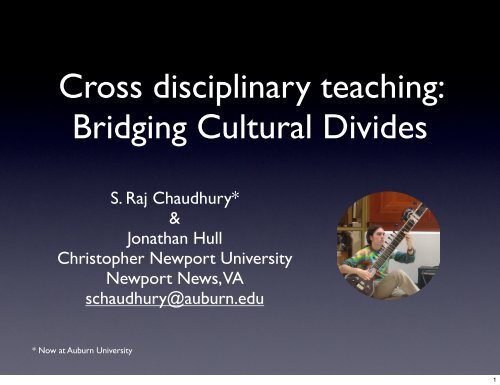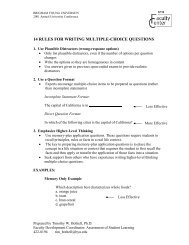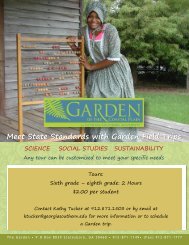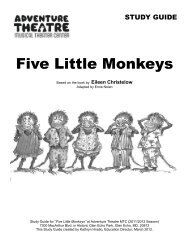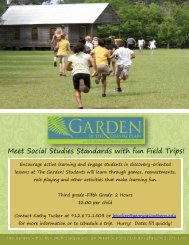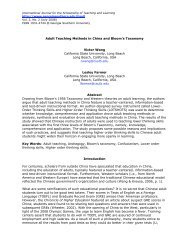S. Raj Chaudhury* & Jonathan Hull Christopher Newport University ...
S. Raj Chaudhury* & Jonathan Hull Christopher Newport University ...
S. Raj Chaudhury* & Jonathan Hull Christopher Newport University ...
Create successful ePaper yourself
Turn your PDF publications into a flip-book with our unique Google optimized e-Paper software.
Cross disciplinary teaching:<br />
Bridging Cultural Divides<br />
S. <strong>Raj</strong> <strong>Chaudhury*</strong><br />
&<br />
<strong>Jonathan</strong> <strong>Hull</strong><br />
<strong>Christopher</strong> <strong>Newport</strong> <strong>University</strong><br />
* Now at Auburn <strong>University</strong><br />
<strong>Newport</strong> News, VA<br />
schaudhury@auburn.edu<br />
1
What is the name<br />
of the instrument<br />
that was playing as<br />
you entered the<br />
room?<br />
Tanpura<br />
2
Physics & World Music<br />
• NOT about the physics of music (strings,<br />
waves, harmonics, overtones etc.)<br />
• ABOUT the teaching and learning of music<br />
by a physics professor (10+ years)<br />
• ABOUT Catalyst events, Tranformations<br />
and Hybrid pedagogy*<br />
• ABOUT deep engagement by student(s)<br />
* Thanks Kathy<br />
3
Deep Engagement<br />
“Learning to be a full participant in the field”<br />
John Seely Brown<br />
4
Scholarship<br />
“World Music Ensembles: Balancing<br />
Institution, Identity and Improvisation”<br />
<strong>Jonathan</strong> <strong>Hull</strong><br />
MUSC 499, Spring 2008<br />
<strong>Christopher</strong> <strong>Newport</strong> <strong>University</strong><br />
Ethnomusicology thesis<br />
literature review and field work in WMEs<br />
Advisors: Brana Mijatovic, S. <strong>Raj</strong> Chaudhury<br />
5
Learning Sciences<br />
How People Learn (NRC 1999)<br />
(life-slc.org)<br />
• Learning in Informal and Formal Environments<br />
Center (Bransford et. al.)<br />
• How did life-wide learning contribute to course<br />
design, implementation and assessment?<br />
6
London, 1968<br />
7
PHYS 141<br />
MUSC 118<br />
8
Science<br />
•<br />
•<br />
•<br />
•<br />
Compare Pedagogies<br />
Introductory one semester<br />
science course<br />
What are typical goals of<br />
such a class?<br />
What does instruction<br />
look like?<br />
What does assessment<br />
look like?<br />
•<br />
•<br />
•<br />
•<br />
Introductory one semester<br />
Indian music ensemble?<br />
What might be typical<br />
goals of such a class?<br />
What does instruction<br />
look like?<br />
What does assessment<br />
look like?<br />
1 credit course, meets once a week for 2 or 3 hours Music<br />
9
PHYS 141<br />
MUSC 118<br />
10
“The introductory laboratory should<br />
engage each student in significant<br />
experiences with experimental processes<br />
including some experience designing<br />
investigations.” (AAPT, 1997)<br />
11
“The goal of the world music ensemble<br />
should [then] be to cultivate creative<br />
capacities and cultural understanding<br />
through active engagement with and<br />
through the tradition” (J.H., 2008)<br />
12
Tabula Rasa?<br />
Did I have a blank slate to write on?<br />
13
Portal of engagement?<br />
14
Catalyst<br />
• Need for World Music Ensemble instructor<br />
• UCLA connection with Ethnomusicologist<br />
• Music dept. desire to provide in-depth<br />
musical experience as opposed to breadth<br />
• I was there, no extra funds needed<br />
• Cooperative Music & Physics dept. chairs<br />
15
World Music Ensemble, Fall 2007<br />
16
Transformative<br />
• North Indian classical & semi-classical (not<br />
World) at a regional college (low diversity)<br />
• Offered three semesters in a row<br />
• Enrollment 10-12 consistently<br />
• Several ‘repeat’ students<br />
• 3 students took Physics class(es) + Music<br />
• Perform at local cultural events for the<br />
ethnic community (!)<br />
17
What pedagogy to use?<br />
“We teach the way we were taught”<br />
Physics Music<br />
“Performance is the crux of the<br />
world music ensemble.<br />
Playing the music is what attracts people<br />
not just learning about it.”<br />
J.H., 2008<br />
18
Apply my Physics pedagogy<br />
• Active Learning<br />
• Formative Assessment<br />
to Music?<br />
... or create a new Hybrid pedagogy?<br />
19
Hybrid Pedagogy<br />
Tabla<br />
Harmonium<br />
20
Limits on the pedagogy<br />
• <strong>University</strong> had no instruments (self)<br />
• Use voice as the medium for instruction<br />
• Instructor<br />
• No degrees or formal coursework in<br />
music (how to satisfy SAACS?)<br />
• No knowledge of Western classical music<br />
• Students<br />
• No auditions to encourage enrollment<br />
• No ethnic Indians; no language courses<br />
21
Assessment<br />
• Typical science class<br />
• Quizzes, tests, lab reports<br />
• Active Learning science class<br />
• Presentations, group work<br />
• World Music Ensemble - PERFORMANCE<br />
22
UCLA Indian Music Performance Group<br />
1986<br />
23
CNU World Music Ensemble<br />
Fall 2007<br />
24
Measures of success?<br />
• Science class<br />
• Student performance on tests etc.<br />
• Music Ensemble<br />
• <strong>University</strong> based experts not available<br />
• Depend on ethnic community<br />
• Performed at Hindu Temple<br />
25
Making Thinking Visible<br />
...full participant in the field?<br />
26
Improvisation & Surprise<br />
27
“I had to use my ears and emotions more to fully<br />
encompass the meaning of the music rather than focus<br />
on meticulous details that I feel now kept me from fully<br />
developing musically” - Student in J.H. 2008<br />
28
Student voices<br />
“The hardest challenge for me was breaking myself<br />
of my trained perspective of music, with this new<br />
perspective. One needs an open and accepting mind,<br />
clear of conventions”.<br />
“At first I tried to apply my former understanding of<br />
music to understanding Indian music. You simply<br />
cannot do that. Indian music works under a<br />
completely different paradigm of thought...”<br />
29
Improvisation Index<br />
Tabula Rasa?<br />
Ethnomusicology Student<br />
Non-ethno student w/o prior Western<br />
Non-ethno student<br />
w/prior Western<br />
30
•<br />
•<br />
•<br />
•<br />
Final thoughts<br />
“To understand and acquire the new system<br />
required problem solving and restructuring of<br />
abstract conceptual processes”<br />
“... it is in experiencing the collisions and problems<br />
that growth from one’s own tradition leads to<br />
growth towards another”.<br />
Cognitive Dissonance & Conceptual Change!!<br />
Goals in Physics & Music could be the same!<br />
31
Acknowledgements<br />
• Students of the WME (07-08)<br />
• Mark Reimer, Brana Mijatovic, CNU Music<br />
Dept.<br />
• The Indian community of Hampton Roads<br />
• Biggio Center, Auburn <strong>University</strong><br />
32


